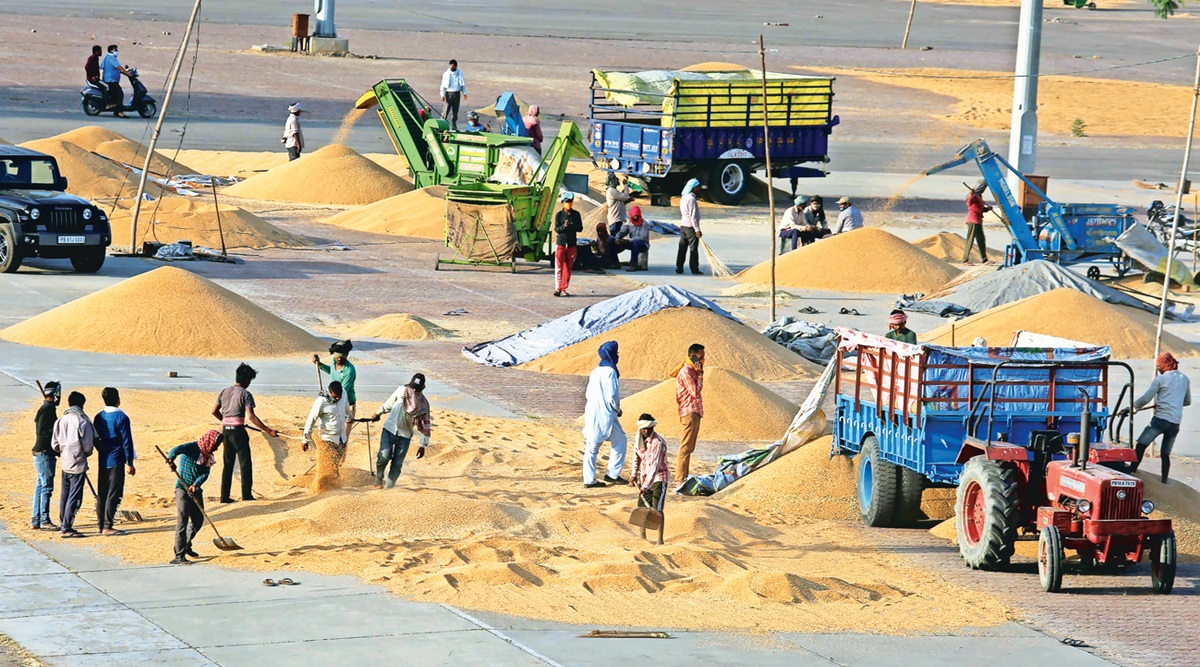Riding on direct payment, Punjab wheat procurement hits new high
Government agencies have procured 132.08 lakh metric tonnes of wheat, 2 lakh metric tonnes more than the target set by the state, with more than 9 lakh farmers receiving over Rs 23,000 crore directly into their bank accounts.
 Food Corporation of India records show that this is the highest wheat procurement in Punjab’s history.
Food Corporation of India records show that this is the highest wheat procurement in Punjab’s history.
In the midst of the second coronavirus surge and the agitation by farmers against agricultural laws that has been now on for five months, Punjab has surpassed all previous records in wheat procurement for the rabi season.
Government agencies have procured 132.08 lakh metric tonnes of wheat, 2 lakh metric tonnes more than the target set by the state, with more than 9 lakh farmers receiving over Rs 23,000 crore directly into their bank accounts. It was the first time in Punjab that farmers were paid directly instead of through arhtiyas or middlemen.
At 34 days, this rabi marketing season, that began on April 10 and ended Thursday, was 12 days shorter than last year.
Food Corporation of India records show that this is the highest wheat procurement in Punjab’s history. The number was under 100 lakh metric tonnes till 2009-10. At over 9 lakh, the number of farmers who came with their grain to mandis this year is also higher than the figure of 8.8 lakh last year.
While the procurement was lesser in the Malwa region, the epicentre of the farmers’ agitation, the jump in Doaba and Majha made up for it. In fact, the districts that saw lesser procurement compared to last year slightly outnumbered those that saw higher.
Incidentally, the higher procurement was despite a slightly lesser yield. While the weather was largely favourable, an unusually warm March meant the average was 49 quintals per hectare compared to 50.04 per hectare last year.
Ravi Bhagat, Director, Department of Punjab Food Supply and Consumer Affairs, said direct payment into the accounts was one of the main reasons for this. “The government has registered farmers on the Anaj Kharid portal and the money was credited into their accounts, not those of arhtiyas… Punjab has also become the first state where the J form that carries the details about the crop a farmer sells to the government is included in the Digilocker. He is not dependent on a middleman for getting the J form.”
Bharatiya Kisan Union (Dakaunda) leader Jagmohan Singh also said that one of the important reasons more wheat came to mandis was direct payment of MSP into accounts, which meant farmers went there instead of to flour millers.
A Punjab Mandi Board official said the other reason was that farmers sitting on dharna also wanted to take advantage of the MSP (Rs 1,975 per quintal), believing it may not last. According to him, more wheat also landed in government mandis due to lesser private players in the market due to Covid.
One such farmer, Gurdip Singh of village Chak Kalan near Jagraon in Ludhiana district, said he had sown wheat on 20 acres and sold around 400 quintals for Rs 8 lakh. “I am very happy with this system with money coming directly. I sold my entire crop to government agencies as the MSP was also better this time.”
Eight big wheat-contributing districts, all in Malwa region, saw procurement fall this year, including Sangrur, Muktsar Sahib, Moga, Mansa, Fazilka, Faridkot, Barnala and Bathinda. However, procurement rose sharply in Doaba region’s Jalandhar, Hoshiarpur, Nawanshahr and Kapurthala districts; and Majha’s Amritsar, Gurdaspur, Pathankot and Tarn Taran districts.
With around 35 lakh hectares dedicated to wheat cultivation, Punjab produces around 17-18 million tonnes wheat annually, with farmers bringing roughly 75% of it to mandis.



